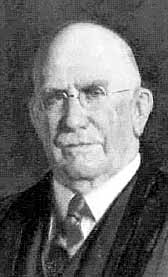 Harris Hancock was a scion of a prominent Virginia horse-breeding family. The family
farm in Ellerslie, Virginia, where Hancock was born just after the Civil War, was renown
for producing a string of champion thoroughbreds. He was educated at the University of
Virginia and Johns Hopkins University, where he received his A.B. in 1888. This was
followed by graduate studies in England at Cambridge University and in Germany at the
University of Berlin where he attended lectures by Weierstrass, Frobenius and H.A.
Schwarz. He obtained a Berlin Ph.D. in 1894 for a thesis on elliptic functions directed by
Lazarus Fuchs. A second dissertation on algebraic number theory, directed by Gaston
Darboux, earned him a D.Sc. degree from the Sorbonne in 1901. Hancock was hired as an
Associate at the University of Chicago in 1892, where Cincinnatian Eliakem Hastings
Moore was Head of the Mathematics Department. Moore and Hancock had a falling out
when Moore (see [KP])
Harris Hancock was a scion of a prominent Virginia horse-breeding family. The family
farm in Ellerslie, Virginia, where Hancock was born just after the Civil War, was renown
for producing a string of champion thoroughbreds. He was educated at the University of
Virginia and Johns Hopkins University, where he received his A.B. in 1888. This was
followed by graduate studies in England at Cambridge University and in Germany at the
University of Berlin where he attended lectures by Weierstrass, Frobenius and H.A.
Schwarz. He obtained a Berlin Ph.D. in 1894 for a thesis on elliptic functions directed by
Lazarus Fuchs. A second dissertation on algebraic number theory, directed by Gaston
Darboux, earned him a D.Sc. degree from the Sorbonne in 1901. Hancock was hired as an
Associate at the University of Chicago in 1892, where Cincinnatian Eliakem Hastings
Moore was Head of the Mathematics Department. Moore and Hancock had a falling out
when Moore (see [KP])
"... refused to promote Hancock at the rate the young man believed he merited. In response to this, Hancock kept up a steady correspondence to [President William Rainey] Harper over the five-year period from 1895 to 1900, in which he extolled his own virtues, asked for promotions, and denounced Moore's treatment of him."Hancock left the University of Chicago in 1900 and was appointed Professor at the University of Cincinnati. He published a number of important books during his thirty eight year career at the University of Cincinnati and was a strong proponent of classical education (and a fierce opponent of the College of Education). Hancock headed a committee of Cincinnati citizens who lobbied for a rigorous, classically-based high school education. The work of this group led directly to the founding of Walnut Hills High School in 1920. He attended the First Annual Meeting of the MAA Ohio Section in 1916 and served as Section Chairman, 1924-25.
Hancock retired to Charlottsville, Virginia in 1937 and died there seven years later.
[CNM] C.N. Moore, "Harris Hancock - In Memoriam", Bulletin of the American Mathematical Society 50(1944), 812-815.
Article by Charkes Groetsch
University of Cincinnati